Heading out the door? Read this article on the new Outside+ app available now on iOS devices for members! Download the app.
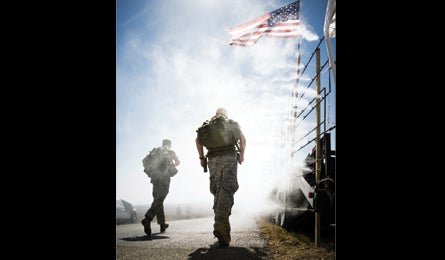
Marchers carrying 35-lb. packs cool off with misters.
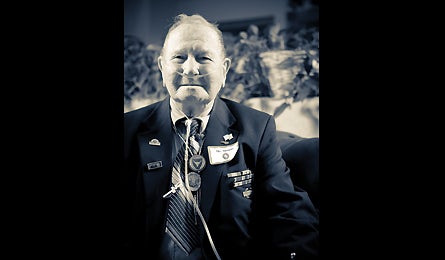
John Mims survived the Bataan Death March.
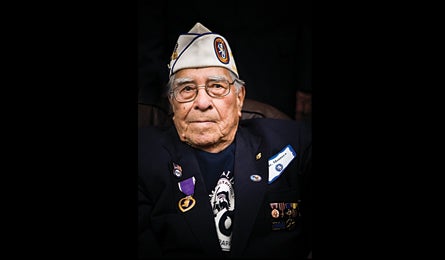
Carlos Montoya walked 11 days with no food or water.
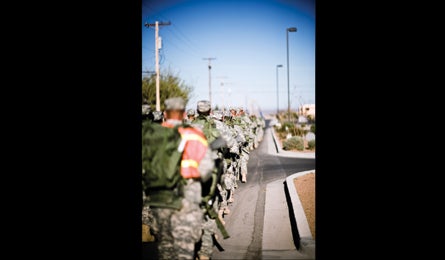
Warming up on White Sands Missile Range.
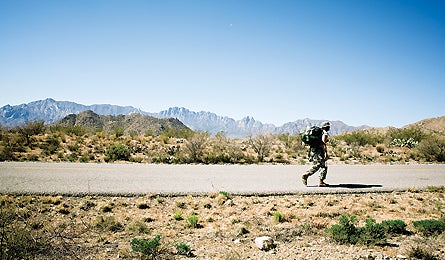
The march passes the Organ mountains.
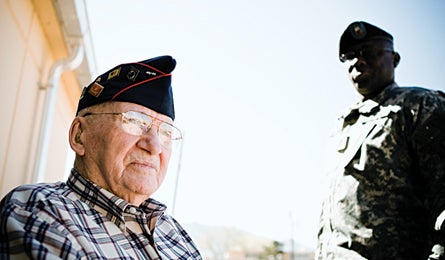
Ben Steele says optimism helped him keep moving.
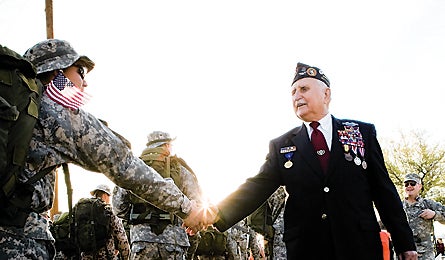
Veteran Glenn Frazier greets memorial marchers.
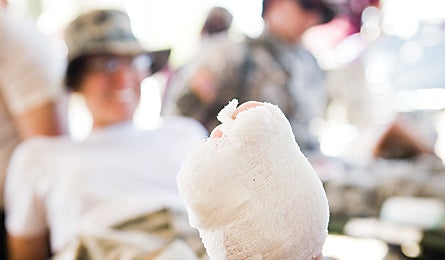
Blisters plague many memorial walkers.
The men, even now, can’t describe how hot it was on Bataan. There’s no way
to say it. Hot as the dickens. Hot enough to fry an egg. Hotter ‘n hell. The
heat couldn’t be explained, only experienced. And it was torture: Sometimes,
the Japanese guards halted columns of surrendered men, forced them to stand
under the open, insistent sky for hours, hatless and withering. Someone dubbed
this the “sun treatment.” But it was better than getting bayoneted while lunging
for a sip of fetid water from a ditch. Getting pistol-whipped for stumbling.
Getting your teeth knocked out, like Private John L. Mims did, with a Coke bottle.
“My mouth felt like a bag of glassware,” he says. “I spit my teeth out, and
some were hangin’ on by half, broke.” And then he kept marching through the
heat.
I think about the temperature in Bataan as I walk through the 85-degree New Mexico
desert. I’ve had a lot of time to think since I woke up this morning on an army-green
cot, lined up with 4,000 others, and started the 26.2-mile Bataan Memorial Death
March. The annual event commemorates the original Bataan Death March, one of
the greatest survival episodes in history. In comparison, of course, calling
this a death march is laughable. I can see buildings on White Sands Missile
Range. I can hear semis rumbling along US 70, heading up and over the Organ
Mountains. Sometimes, I pass guys in fatigues and women wearing spandex. Sometimes,
they pass me. “Power through, ma’am,” the men say. Ma’am.
But after seven hours, my feet feel like roadkill and my shoulders–thanks
to a 38-pound pack–are grousing, big time. For a moment, I wonder if I’m
going to make it. I’d been warned about how tough the Memorial Death March is.
How boot-camp-proof Marines often don’t finish. I signed up as a way to test
myself. To push my physical and mental limits and to answer, admittedly under
controlled conditions, the question we all wonder: Do I truly have what it takes?
Equally important, I wanted the opportunity to meet and learn from the real
Bataan survivors–the soldiers who trudged for 70 miles with no food or
water, who were beaten for slowing down, and who kept walking through that awful
heat when they were sure they couldn’t take another step.
It’s an opportunity that won’t be available much longer. The World War II veterans,
now in their frail and wobbly late 80s and early 90s, know they’re on the brink.
And after trying for decades to forget what they went through, suddenly they
don’t want to be forgotten. They come to White Sands every year to be commemorated,
to be honored. They want us, maybe, to feel a small part of what they experienced
and wonder to ourselves if we could have made it. The Memorial Death March is
a way of meeting in the middle for a shared glimpse, a mere taste, of suffering
and survival.
About 15 miles in, I pass Army Aircorpsman Ben Steele, 91, who had been driven
here so he could cheer marchers along. As if we deserve cheers from him. When
he returned from Bataan, Steele painted what he’d seen–Filipinos throwing
biscuits to POWs along the road from Mariveles to Camp O’Donnell; soldiers collapsed
in the dust–because it took a generation before he could talk about it.
“How’re your feet?” Steele asks. He grins and teeters up to give me a hug.
“I’m getting a few blisters.” I say it, then feel stupid. The whole contrivance
of what I’m doing compared to what these men endured is almost embarrassing.
“You know how I made it through the Death March?” Steele asks. “I stole a sock
off a dead guy. Every time we stopped, I rotated that sock. It saved me. Blisters
literally killed people.”
The Army ROTC unit at New Mexico State University started the Bataan Memorial
Death March in 1989 to commemorate their own: Many of the 1,800 men from New
Mexico’s 515th and 200th Coast Artillery units who were sent to the Philippines
in the fall of 1941 were captured and ruthlessly herded across Bataan. Fewer
than half came back. The memorial march takes place in the open country around
the headquarters of 3,200-square-mile White Sands Missile Range, where dun-colored
buildings huddle under 8,990-foot Organ Needle in the Chihuahuan Desert. The
course starts and finishes in front of the Frontier Club (think Elks-lodge-meets-Motel-6).
It passes by the Missile Park, a gravel garden of vintage rockets pointed heavenward.
Then through the Owens Road arroyo, where the sand gets fine and soft; up and
around the dusty cone of Mineral Hill; and through the ankle-deep Sand Pit at
around mile 22. Then back to the Frontier Club.
It’s rough walking, to be sure, but 26 miles with aid stations and medical
tents can’t be too bad. So to enhance my pseudo-suffering, I decided to wear
boots I’d put on once. And I entered the so-called Heavy category: Marchers
carry 35-plus pounds over the entire marathon distance. Though even that seems
trivial when you learn the complete story of the Bataan survivors.
In the fall of 1941, the United States sent troops to the Philippines to head
off a Japanese buildup in the Pacific. After Pearl Harbor was bombed, Japan
invaded the Philippines, pushing the American and Filipino soldiers down Luzon
onto the dead-end of the Bataan Peninsula. Part of the problem: These Americans
wore WWI-era helmets, carried 1903 Springfield rifles, and drove tanks with
no recoil oil. They were simply outmatched by Japan’s modern weapons.
In January 1942, President Roosevelt decided to spend his military budget on
the war in Europe. Europe First, the policy was called. (Bataan Last, it implied.)
War Secretary Henry Stimson put it this way: “There are times when men must
die.” In March, Roosevelt ordered General MacArthur to evacuate to Australia.
The Americans on Bataan were abandoned. They came up with a rallying cry that’s
still shouted at the beginning of every Memorial Death March:
We’re the battling bastards of Bataan
No mama, no papa, no Uncle Sam
No aunts, no uncles, no cousins, no nieces
No pills, no planes, no artillery pieces
And nobody gives a damn.
But they kept on fighting–until April 9, 1942, when General Edward King
met with General Masaharu Homma and conceded. It was one of the low points in
U.S. military history, the largest surrender ever on foreign soil. No one knew
what to do. The Americans had never been instructed on how to lay down arms.
The Japanese hadn’t expected so many prisoners, didn’t think they’d be so sick
and wounded, thought it would be no problem to march them from Mariveles to
Camp O’Donnell, a distance of about 70 miles. Even worse, the very idea of surrender
was beyond them: In Bushido, the code of the Samurai, captives were regarded
as subhuman–and often treated as such.
No one really knows how many men marched, or how many died. Some say it was
60,000 Filipinos and 10,000 Americans who marched, and 10,000 that died. Men
fell, were bayoneted, shot. Men were run over, run through, run into the ground.
And the Japanese soldiers frequently ripped off dog tags, tossing them aside.
The practice turned existence into a rough estimate.
The death toll wouldn’t have been so horrendous if the troops were in better
shape at the outset. When American and Filipino soldiers started north, they
were already seriously compromised. While holding off Japanese forces for all
those months, they had lived on smaller and smaller rations. Halves became quarters.
A little bit of flour, sugar, canned milk, and meat. A thousand calories a day,
maybe. Europe First. (Bataan Last.) When their rations weren’t enough, the men
killed their horses and mules, then killed fish with hand grenades. They boiled
ravens and trapped iguanas, ate the crickets off the leaves and the leaves off
the trees. As they got weaker, they picked up tropical diseases: malaria, dysentery,
and beriberi–a deficiency of thiamine that causes feet and hands and balls
to swell like udders.
“In prison camp, I had it so bad that I probably weighed 300 pounds,” says
Steele. “Mostly water.” He even got beriberi in the head, so that when he woke
up after sleeping on his side, one half of his head was bigger than the other.
Translated from Sinhalese, a language of Sri Lanka, beriberi means “I cannot,
I cannot.”
A “love-in.” That’s what Gerry Schurtz, who currently organizes the Bataan
Memorial Death March and whose father died on the Japanese “Hell Ship” Oryoku
Maru, calls the event. Young people patting old people on the back. Old people
crying. Strangers hugging. Love of country, love of history. T-shirts read:
“This land isn’t free without the brave.” Bumper stickers read: “If you don’t
get BEHIND our troops, get in FRONT of them.” Peach-fuzzed Iraq vets walk by
with two artificial legs, or bodies like Reggie Bush, in wife-beaters and baggy
shorts. A British team huddles on the steps; one, wearing Desert Storm–style
camo, says, “I was here last year, and the march was the hardest thing I’ve
ever done.”
Inside the community building, where participants register, crowds stand in
line to meet survivors and get autographs. For a short time, the old men are
like teen idols: Kind-faced Abel Ortega, dressed in a maroon uniform with yellow
trim and a matching garrison cap, signs copies of his book, Courage on Bataan
and Beyond. Glenn Frazier, with a white mustache and black leather vest,
hands out flyers about his new book, Hell’s Guest. He talks about how
hatred is bad for the health. William Eldridge doesn’t say a thing. John Mims,
from Pinehurst, North Carolina, sits next to his rolling oxygen tank. Young
women line up to shake his hand.
Many Bataan veterans credit their survival to luck–good and bad. You
were in the right place at the right time, or the wrong place at the wrong time.
Who’s to say why the man next to you dies from malaria, and you don’t? Why was
that kid shot, and this kid wasn’t? Everyone quickly learned to take the line
of least resistance: Do what you’re told, try not to be obvious, don’t stop,
don’t fall.
Carlos Montoya marched for 11 days, and during one quick break he sagged against
a tree, trying to rest. A Japanese soldier ordered him–jabbing a bayonet–to
move, and Montoya didn’t. The guard yelled. Montoya prayed. The guard finally
left him alone. Lucky.
But one man’s luck is another’s resourcefulness: Ben Skardon always walked
in the middle of the column of four–all the farther from rifle butts and
bayonets. Survival could be as simple as a few chlorine pills stashed in a pocket,
a comfortable pair of shoes, a bottle of iodine. A stolen sock. One kid pulled
the helmet off a puffed-up Filipino corpse, gave it a wipe, donned it. Skardon
chugged a can of condensed milk before the March started–one more can
than the next guy. The weak and the sick and the injured faltered, dropping
from the front of the column to the middle to the sagging rear, where strangers
would hold them up for a while, maybe, until their weight became too close to
dead weight and they fell off the back and disappeared.
The lights come on with a pop at 4:00 a.m., three hours before the start. I’m
in a gymnasium. The floor is covered with a gymnasium-size blue tarp. And the
blue tarp is covered with men. Soldiers, hundreds of them, do their routines
with their feet, their teeth, their hair. Most of them pull on fatigues and
buff-colored lace-up boots, tighten their belts, lift their packs and set them
down. Count out energy bars and eat bananas. They pack their stuff and fold
up their beds and line things up in a row. I stumble around, trying to remember
where I put my washcloth. By the time I heft my 38-pound pack and walk to the
start, the gym is empty.
At the opening ceremony, thousands of men (and the occasional woman; only 49
female participants end up completing the Heavy march) mill around under klieg
lights in the dark, eating muffins from plastic packages. An American flag,
as long as a bus and hanging off a fire truck crane, flaps in the wind–which
is already gusting warm and strong. The porta-potty lines reach 40 people deep.
We all line up while the color guard marches in, and someone reads off the
names of all the Bataan survivors who have passed away since last year, and
someone plays taps, and we belt out O Say Can You See, and then yell the oath
of the Marines: I will always place the mission first. I will never
accept defeat. I will never quit.I will never leave a fallen comrade.
There’s a lot of saluting and stiff-legged stomping of boots. The civilians–about
a quarter of the total participants–slouch around, looking vaguely guilty.
I’ve never been particularly patriotic. Entitled is more like it: Of course
my life is good. Of course I deserve it. Never mind that I haven’t done anything
to earn it. The Greatest Generation has always been an abstraction to me. Before
today, I’d never spoken to a WWII survivor or really considered, beyond what
was in my textbooks, the idea of sacrifice. Current and recent wars have left
me disillusioned rather than inspired. But standing in a sea of creased camo
and erect spines, the thought of putting my hand to my heart momentarily feels
right. Not, perhaps, because I feel a sudden burning patriotism, but because
I feel a profound and surprising tenderness for the men of Bataan. For my good
fortune. And for the people around me who truly believe America is worth marching–not
to mention dying–for.
And then the gun goes off. At the starting line, survivors sit in metal chairs,
holding out crooked-knuckle hands to marchers. “Thank you, thank you,” they
say. They’re thanking us. We’re about to walk in a 26.2-mile circle with 12
water stops and six medical tents and 262 medical personnel, and the race organizers
already gave us our medals–shaped like dog tags–in our registration
packets. Yet Carlos Montoya, wearing a blue blazer and a white garrison cap,
looks up at me and says, “You’re my hero.”
Are survivors born, or made? Maybe both. Montana-bred Ben Steele was brawny
and happy. He dropped out of high school to work on ranches. “I was a cowboy
and I camped out half my life,” he says. “I had a lot of optimism in my upbringing.
A lot less bitterness and anger. It got me through the war.” At age 16, Abie
Abraham broke the world record for sitting in a tree (121 days). Talk about
will.
The U.S. Air Force Survival Manual describes the will to survive as
“the desire to live despite seemingly insurmountable mental and/or physical
obstacles.” Tools and training, manuals, schools, TV shows–they only go
so far. After that, things become much more visceral and basic: Do you decide
to keep going, or not? In the Korean War, prisoners called this give-up-itis,
and the syndrome alone is thought to have caused 50 percent of POW deaths. The
Dictionary of Psychology describes give-up-itis as “the condition
in which a patient loses hope, relinquishes all interest in survival, and eventually
dies.” The term didn’t exist in WWII, but Bataan survivors often evoke the same
image: A man gazing into the distance, empty. A man refusing to take another
step.
The men who kept walking went through classic stages of survival. First, there’s
the crisis period: You realize you’re in deep shit. Then there’s the coping
period: You resolve to endure, rather than concede. You think constructively
rather than panic. You tolerate pain and you handle fear. Sometimes, you hate
or love something so much–enemy soldiers, your wife, your kid–that
you persevere. And, a lot of the time, you pray.
Some men already had faith when they started walking, like Frazier: “I knew
He walked along with me on the march. He gave me strength to resist the temptation
of trying to get water.” Some men lost faith as they walked: “When I prayed,
there was no result,” says Steele. “So I couldn’t believe in God–where
was He?” And some men found faith the more steps they took. Not God perhaps,
but hope.
New research suggests that the Bataan survivors may have had more than faith
or luck or happy childhoods. Charles A. Morgan, a professor of psychiatry at
Yale University, has spent 15 years examining soldiers in SERE training–Survival,
Evasion, Resistance, and Escape–and his research has shown that a soldier’s
hormone levels affect how he performs under high stress. In a 2000 study in
Biological Psychiatry, Morgan showed that highly trained Special Forces
soldiers, immediately after military interrogation at the U.S. Army survival
school, showed higher levels of a stress-buffering hormone called neuropeptide-Y
(NPY) in their systems than non–Special Forces soldiers. NPY works on the prefrontal
cortex of the brain to keep you focused on tasks under stress. It’s also been
associated with resilience, which, in psychology, is defined as an individual’s
capacity to handle stress–and not end up with mental dysfunction because
of it. In another study in the American Journal of Psychiatry, Morgan
determined that “stress-hardy” individuals experience less dissociation–or
emotional numbing–during acute stress.
The upshot? The will to survive can actually be learned. “You can become more
resilient at any point in your lifetime,” says Salvatore Maddi, a professor
of psychology at the University of California, Irvine, and the author of Resilience
at Work. “What you increase is hardiness–a pattern of attitudes and skills
that augment resilience.” You learn to stay committed, no matter what. Stay
under control. See stress as normal. Problem-solve. You can respond to difficult
situations with less adrenaline–and keep your head about you. Later, when
I asked Maddi whether the Bataan Memorial Death March made me tougher, he said,
“It’s a great example of hardiness. Not only did it help you complete the march
successfully, but you’re using the feedback you obtained to grow in hardiness.
It will certainly enhance your resilience in the future.” Translation: The next
time I climb a fourteener, perhaps I’ll find the physical effort less mentally
taxing. Or at least be able to handle bigger blisters–for longer.
The men of Bataan didn’t have SERE. They didn’t get electrodes and manuals
and simulations. In fact, it was only in the midst of WWII that the idea of
teaching mental survival–as opposed to hard skills–became widespread:
Outward Bound was started by educator Kurt Hahn in 1941, when he heard that
young merchant seamen, torpedoed by German U-boats, weren’t surviving at sea
as well as their older comrades. They couldn’t cope with life, Hahn thought.
They lacked self-reliance and tenacity. Hahn devised a month-long training course
out of Aberdovey, Wales, that was a mix of cross-country routefinding, expeditions
across mountain ranges, small-boat instruction, rescue practice, and athletic
competitions. It was like stress-inoculation training–similar, in some
ways, to actual physical immunization. Bump into the edge of your possibility,
endure, and end up stronger for the next difficult encounter. Hahn’s motto was
simple: Plus est en vous. There is more in you than you think.
After walking a mile or two down a sizzling paved road, around mile 18, my
feet are on fire. It’s worse than going uphill. My trekking poles click on concrete,
my legs feel like lead. In my own sort of survival mode, I’ve resorted to listening
to Justin Timberlake on my iPod. I can stop, of course.
Catch a van ride back to base and call it a day. Drop my pack, finish without
weight, and get disqualified from my category. My physical pain is, in some
ways, totally pointless: I’m not trying to stay alive. Adrenaline isn’t surging
to my heart, and emergency glucose stores are not flooding my muscles. The human
instinct is to avoid pain, of course, but if pain is simply part of the path
to survival, it must be ignored.
I manage to ignore it for 15 more minutes. When I pass a water stop at mile
20, I decide it’s time to get help. An olive-green tent sits next to the road,
plastic windows snapping in the wind. Soldiers lie on a row of cots in front
of it. I drop my pack, sit down, and start untying my boots.
A medic squats in front of me. “What’s the problem, ma’am?” Ma’am. I tell him
about my blisters–a couple here, maybe a couple there.
We pull off my socks, then try pulling off the duct tape and Band-Aids. They
stick to the blisters. The tape has caused new blisters next to the old blisters,
and those blisters have also grown blisters. Some of them are as big as quarters.
I’m amazed, and disappointed, at how wimpy my feet are–which reminds me
of Ben Steele and his third sock. I’ve gone through six socks in seven hours
and I have two dozen lesions.
“Um, let me get someone else here,” says the medic. Another one comes over.
She grabs a third. He calls the guy who’s in charge of this tent. That guy runs
to get his camera. After heated debate, they carry me inside the tent and lance
a few of the biggest blisters. Stuff squirts out.
The whole process takes an hour. For some reason, it bothers me–though
it hardly matters whether I finish in 8.5 hours or 9.5 hours. The athlete in
me sees people walking by while I’m getting babied. The sage in me knows that
I’m walking, and walking isn’t racing, and it’s about the journey rather than
the destination. The momentary patriot in me thinks about the old men, and how
they marched and marched and didn’t know where the end was or what it was. They
just put one foot in front of the other until even their fingernails and nosehairs
were exhausted.
My end is obvious: where I started. But when the men got to the end of the
Bataan Death March, it was just the beginning of their odyssey: They had to
ride 24 miles in boxcars–packed so tight that if someone expired standing
up, he wouldn’t even fall to the ground. And then the men had to march eight
more miles to Camp O’Donnell, where there was one water spigot for 10,000 prisoners
and 29,000 men died–and the men who lived spent all of their time putting
their friends in the ground.
After O’Donnell, the men were sent all over: Beverly Skardon ended up in the
dark, crowded belly of the Oryoku Maru, which was accidentally attacked
by Navy divebombers. Glenn Frazier started on the Tabayas Road Detail, then
got sent to Bilibid Prison in Manila, then Osaka, then Tsuraga. Ben Steele’s
weight dropped from 170 pounds to 82. The men were in prison for years, tortured,
starved. They laid their jabbing bones on bamboo slats. They watched as their
friends took on million-mile stares, then gave up. But these men somehow persevered–with
their faith or their hatred or their hormones. “I was given the Last Sacrament
three times,” says Steele.
At my last water stop, kids hand out cups filled with Lucky Charms and salty
peanuts. The course goes straight for miles, then loops around the perimeter
of the base, along a high wall next to some big peach-colored houses. When I
turn the corner to the finish, a crowd four-deep cheers loud and long–though
the winners passed by hours ago. I don’t see any veterans. It’s been a long
day for them. They’ve shaken a lot of hands, deflected a lot of praise.
I stop into the medical tent to get my feet cleaned up. Next to me, there’s
a kid–maybe 19–lying on his stomach. And there’s a blister on his
foot as big as a sand dollar. A few cots away, someone passes out. The yell
goes out: “We need fluids!”
That night, I eat at the Frontier Club–pasta and red sauce on metal trays,
lemonade from a dining-hall soda machine. I sit with Steele and Ortega and Murphy.
As we talk over the food, they talk about food: One of them describes
a recipe for quan, a Filipino word that means “everything that’s edible.”
Guffaws. Another remembers that he and his comrades made a pact that when they
got out of Bataan, they’d buy a grocery store and fill it with food–then
lock themselves inside and never, ever come out.
The men chuckle over the memory of a hunger I can’t even imagine.
At the airport the next morning, I see a man so sunburned that his whole right
leg is welted scarlet and wrapped in gauze. Soldiers with huge biceps and tight
calves lie under benches with their feet taped, and twentysomethings limp through
the terminal wearing Bataan Memorial Death March medals around their necks.
And I see Ben Steele, staring out the window, watching the planes go by as
he grips his cane. He grins and gives me a hug, and he talks about the third
sock and the beriberi and what, again, a group of Death March survivors discusses
over dinner. “Glenn Frazier–now that guy can tell a tall tale,”
he says with a smile. I picture the men, safe and weathered and soft around
the middle, laughing about hell.